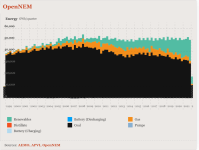Hermit
Cantankerous grump
Origin Energy announced today that it will be closing Australia's largest power plant (which is also Australia's largest coal-fired power plant) in mid-2025 instead of 2032. The power plant has a nameplate capacity of 2880 megawatts and produces nearly 20 million tonnes of greenhouse pollution into the atmosphere every year.
From the Australian Financial Review:
From the Australian Financial Review:
The decision is clearly based on cold-nosed economic considerations. Despite massive fossil fuel subsidies, underpinned by our current Prime Minister's fervent and decades long support, coal-fired power plants keep losing commercial viability.Chief executive Frank Calabria said Origin’s proposed complete exit from coal-fired power generation “reflects the continuing, rapid transition of the NEM as we move to cleaner sources of energy”.
“Australia’s energy market today is very different to the one when Eraring was brought online in the early 1980s, and the reality is the economics of coal-fired power stations are being put under increasing, unsustainable pressure by cleaner and lower cost generation, including solar, wind and batteries,” Mr Calabria said.
[...]
The news on Eraring comes after the Australian Energy Market Operator has warned of the likely accelerated closure of baseload coal power plants, which are becoming increasingly uneconomic with the rise of cheap renewable power.
Origin’s rival AGL Energy last week also brought forward the dates for its two largest coal plants to close, although it still is assuming its Loy Yang A plant in Victoria will run until 2045.


